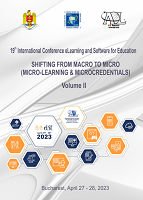DIGITAL COMPETENCIES OF TEACHERS AND STUDENTS IN THE FIELD OF SECURITY AND DEFENCE
DIGITAL COMPETENCIES OF TEACHERS AND STUDENTS IN THE FIELD OF SECURITY AND DEFENCE
Author(s): Marina Marchisio, Fabio Roman, Matteo SACCHET, Enrico Spinello, Linko Nikolov, Paulina Owczarek, Cristian-Emil MoldoveanuSubject(s): Education, Security and defense, ICT Information and Communications Technologies, Sociology of Education, Distance learning / e-learning
Published by: Carol I National Defence University Publishing House
Keywords: Digital Competencies; Digital Education; Inter-university Education; Officers Training; Security and Defence Education; Students Digital Skills; Teacher Training;
Summary/Abstract: Digital technology has become an integral part of teaching and learning. Teachers and students need to possess digital competencies to be effective in their activity. The aim of this paper is to investigate how to design training activities that can help teachers and students develop digital competencies. It is crucial to assess the current level of digital competencies of the people involved. The training objectives should be aligned with the actual frameworks on digital competencies. The activities themselves should be interactive, engaging, and practical, without forgetting theoretical components. It is essential to use a variety of training methods, such as workshops, online training, and coaching, to cater to the different learning styles of the teachers. This paper discusses the systematic approach adopted in the context of the European project DIGICODE. The aim of the DIGICODE project is to improve the security and defence education quality by using digital tools in the didactic activities and by developing digital competences of teachers. Project partners are European Universities and Military Institutions that deal with the training of officers. Results will focus on the data collected in a school “Systems for Command and Control in Security and Defence Field”, which involved teachers and engaged students on the topics of the project. Findings connect various dimensions: the (P) Pedagogical, the (H) Human, the (T) Technological and the (I) Institutional one. The discussion also highlights the importance of a careful design through collaborative working and sharing of ideas across different disciplines.
Journal: Conference proceedings of »eLearning and Software for Education« (eLSE)
- Issue Year: 19/2023
- Issue No: 02
- Page Range: 170-179
- Page Count: 10
- Language: English

